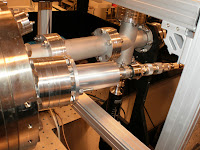In this post, I will introduce some details of the Sample Chamber and explain their function.
1 - At the side of the Sample Chamber one can view through a big window into the chamber and see the carousel holding multiple samples. We have a standard piece mounted with diaphragm’s, a phosphor screen and test samples such as ZnS and ZnSe.
2 - The rotational feed through mounted on a x,y,z stage. We can rotate the right sample into the electron beam, retract the complete carousel out of the electron beam line and displace the sample through the electron beam.
3 - Behind the sample chamber but before the electron beam dump a beam viewer can be inserted into the electron beam. Using a Gigabit Ethernet CCD Camera we are able to follow the electron beam at a high frame rate.
4 - Here you see the beam dump at the deflected output port of the sample chamber. Using this beam dump, we can optimize the electron beam without irradiating the sample and causing unwanted degradation.
5 - Input window of the laser beam to the sample. We are not only able to excite the samples with the electron pulses, but in the same sample chamber we can excite them also with the laser pulse. In this way we can compare laser flash photolysis with electron beam photolysis without exchanging the sample to different experimental setups.

































